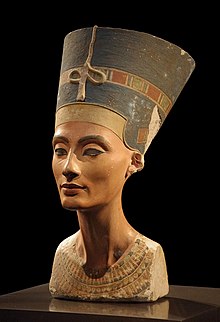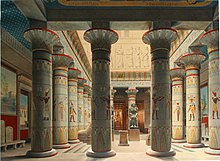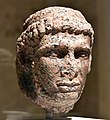Egyptian Museum of Berlin

TheEgyptian Museum of Berlin(‹See Tfd›German:Ägyptisches Museum und Papyrussammlung) is home to one of the world's most important collections ofancient Egyptianartefacts, including the iconicNefertiti Bust.Since 1855, the collection is a part of theNeues Museumon Berlin'sMuseum Island,which reopened after renovations in 2009.
History
[edit]
The museum originated in the 18th century from the royal art collection of theHohenzollernkings ofPrussia.[1]Alexander von Humboldthad recommended that an Egyptian section be created, and the first objects were brought to Berlin in 1828 under KingFriedrich Wilhelm III.Initially housed inMonbijou Palace,the department was headed by theTriestemerchant Giuseppe Passalacqua (1797–1865), whose extensive collections formed the basis. A Prussian expedition to Egypt and Nubia led byKarl Richard Lepsiusin 1842–45 brought additional pieces to Berlin.
In 1850, the collections moved to its present-day home in the Neues Museum, built according to plans designed byFriedrich August Stüler.The Nefertiti Bust, discovered during the excavations byLudwig BorchardtinAmarna,was donated to the museum by the entrepreneurHenri James Simonin 1920; it quickly became its best-known exhibit. After World War II, during which the Neues Museum was heavily damaged bystrategic bombing,the collections were divided betweenEastandWest Berlin.The main part remained in East Berlin and was displayed at theBode Museum,while those artifacts evacuated toWest Germany,including the Nefertiti Bust, returned to West Berlin. From 1967 to 2005, these items were housed vis-à-visCharlottenburg Palace.The whole collection was reunited again after theReunification of Germany,when it returned to Museum Island.[1]
Collection
[edit]The collection contains artefacts dating from between 4000 BC (thePredynastic era) to the period ofRoman rule,though most date from the rule ofAkhenaten(around 1340BC).[2]
The most famous piece on display is the exceptionally well preserved and vividlycoloured bust of Queen Nefertiti.The collection was moved fromCharlottenburgto theAltes Museumin 2005 and was rehoused within the newly reconstructedNeues Museumon Berlin'sMuseum Islandin October 2009.
Gallery
[edit]-
Kalabsha Gate, from theTemple of Kalabsha,donated as part of theInternational Campaign to Save the Monuments of Nubia
-
Figure of a girl with a cat and standing figure of a young woman, 18th Dynasty,c. 1380and 19. Dynasty, Abusir el Meleq and Thebes
-
Head of a statue of kingPtolemaios X(reign 110–88 BC)
-
Tai-tai, the Priest.New Kingdom,Eighteenth Dynasty,1380 BC
-
QueenTiye,Amarna Period,1355 BC
-
"Berlin Green Head",100-50 BC
See also
[edit]References
[edit]- ^ab"Egyptian Museum and Papyrus Collection".Encyclopædia Britannica.Retrieved24 April2010.
- ^"Egyptian Museum and Papyrus Collection".Staatliche Museen zu Berlin. Archived fromthe originalon 2 July 2010.Retrieved24 April2010.




![Head of Amarna Princess [de]](https://upload.wikimedia.org/wikipedia/commons/thumb/4/4a/Portrait_head_of_one_of_the_daughters_of_Akhenaton_and_Nefertiti_from_a_composite_statue_09.jpg/93px-Portrait_head_of_one_of_the_daughters_of_Akhenaton_and_Nefertiti_from_a_composite_statue_09.jpg)
![Relief Portrait of Akhenaten [de]](https://upload.wikimedia.org/wikipedia/commons/thumb/b/b8/ReliefPortraitOfAkhenaten02.png/108px-ReliefPortraitOfAkhenaten02.png)



